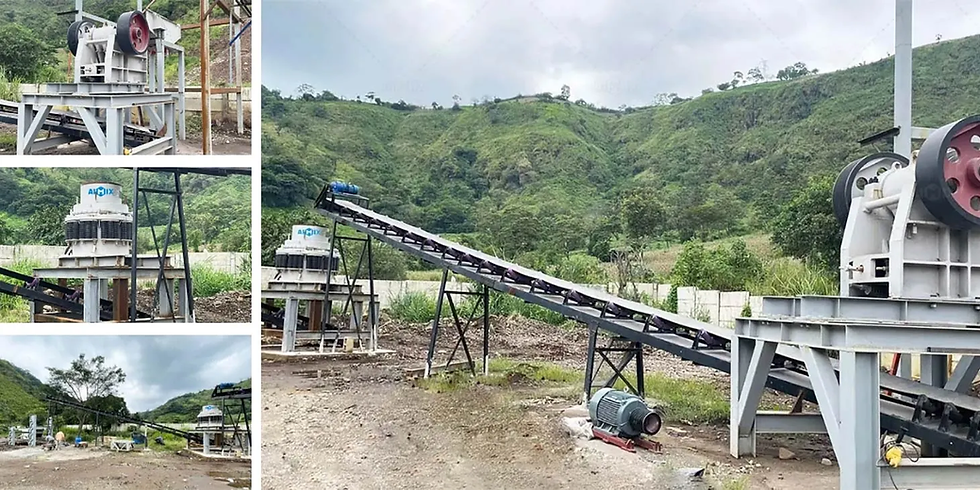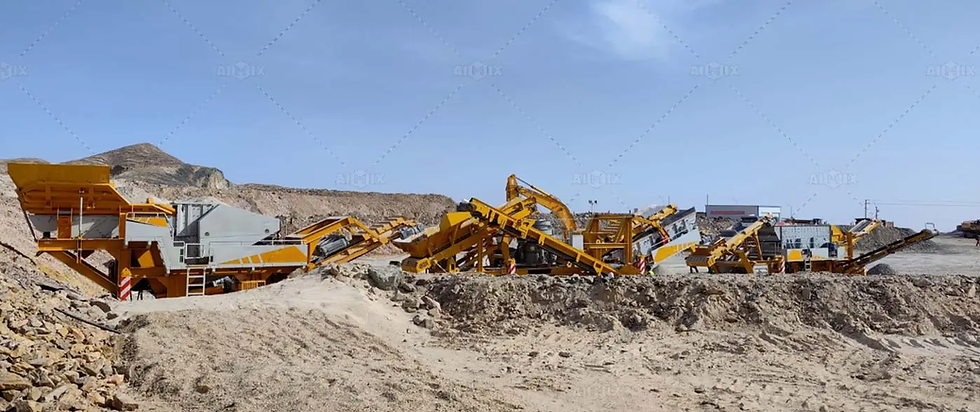Granite Crushing Demystified: The Best Crushers for High Hardness and Iron-Rich Rock
- aimixgroup china
- Aug 16
- 3 min read
Granite stands as one of nature’s most formidable construction materials—its crystalline structure imbued with quartz, feldspar, and often iron-rich minerals that challenge conventional crushing equipment. Unlike softer sedimentary rocks, granite demands machinery engineered for relentless abrasion resistance and compressive force. Yet not all stone crushers are created equal when confronting this igneous titan. The wrong choice leads to premature wear, excessive energy consumption, and inconsistent aggregate gradation.
The key lies in matching crusher technology to granite’s unique properties—its Mohs hardness of 6-7, unyielding compressive strength (200-300 MPa), and frequent iron oxide inclusions that accelerate wear. From jaw crushers with optimized nip angles to cone crushers fortified with specialized alloys, the right equipment transforms an otherwise punishing operation into an efficient, cost-effective process. This guide explores the optimal crushing solutions for high-hardness, iron-rich granite.

Primary Crushing: Taming the First Line of Defense
Heavy-Duty Jaw Crushers with Optimized Kinematics
Not all jaw crushers withstand granite’s abrasiveness. A robust primary crusher must feature steep toggle angles (22-26°) to enhance nip action, ensuring efficient fragmentation without excessive plate wear. Models like the Nordberg C150 incorporate manganese steel jaws with a unique "wave" profile that reduces recirculation and boosts throughput by 15-20%. For iron-rich varieties, chromium-enhanced liners extend service life by 30% compared to standard manganese.
Gyratory Crushers for High-Tonnage Operations
When processing over 1,000 tph of granite, gyratory crushers outperform jaws in both efficiency and longevity. Their constant, circular crushing motion generates less wear per ton than the reciprocating action of jaw granite crusher machine. The Sandvik CG850, for instance, crushes granite with a 50% longer liner lifespan due to its integrated main shaft position monitoring, which prevents metal-to-metal contact during uncrushable events—common with iron-laden feed.
Secondary and Tertiary Crushing: Precision in Particle Reduction
Cone Crushers with Advanced Chamber Designs
Secondary crushing demands precision. Cone crushers like the Metso MX Multi-Action feature patented "Multi-Action" technology that dynamically adjusts the crushing stroke and cavity geometry, optimizing particle shape while reducing energy use by 10%. For iron-rich granite, tungsten carbide-reinforced mantles and concaves resist micro-fracturing, a common failure mode when processing abrasive, high-density rock.

Vertical Shaft Impactors (VSIs) for Cubical Aggregate
When premium particle shape is non-negotiable—such as for concrete or asphalt aggregates—VSIs excel. The Barmac B-Series employs a rock-on-rock crushing principle, minimizing wear from iron content while producing optimally shaped grains. Its cascading material feed system ensures even distribution, preventing localized wear and extending rotor life by up to 40% in high-silica granite applications.
Specialized Considerations for Iron-Rich Granite
Wear-Resistant Alloys and Smart Liners
Granite with magnetite or hematite inclusions accelerates wear exponentially. Modern solutions include:
Ceramic-impregnated liners that reduce metal loss by 50% in high-iron feed.
AI-driven wear monitoring that predicts liner replacement before failure occurs, preventing unplanned downtime.
Hybrid rotors combining high-chrome iron and composite materials for impact crushers, balancing durability and replacement cost.
Magnetic Separation Pre-Crushing
Some iron-rich deposits benefit from pre-processing. In-line magnetic separators installed before secondary crushing remove ferrous minerals, reducing rock crusher machine wear and improving final product purity. A Norwegian quarry processing iron-rich granite reported a 22% reduction in liner costs after installing a 1.5 Tesla overband magnet.
Energy Efficiency in High-Hardness Crushing
Granite’s resistance strains power systems. Solutions include:
Variable frequency drives (VFDs) that adjust motor speed based on load, cutting energy use by 15-25%.
High-efficiency eccentric bushings in cone crushers that reduce friction losses.
Regenerative braking systems in hybrid crushers that recover kinetic energy during idle phases.
Conclusion: A System, Not Just a Machine
Crushing granite efficiently requires more than selecting a durable crusher—it demands a cohesive system. From primary jaws with optimized kinematics to tertiary VSIs producing perfectly shaped aggregate, each stage must complement the rock’s unyielding nature. With iron-rich varieties, wear management becomes paramount, necessitating advanced alloys, intelligent monitoring, and sometimes pre-processing.
The future? Smart crushers that autonomously adjust settings based on real-time ore hardness readings are already in testing. Until then, the right combination of proven technology and strategic wear protection ensures granite’s transformation from quarry monolith to premium aggregate remains both economical and efficient.

Comments